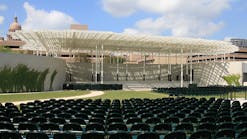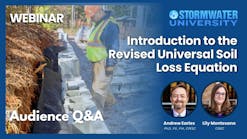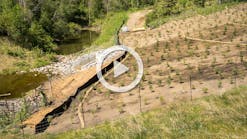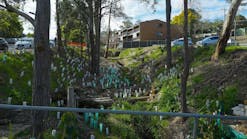With development comes an increase in impervious surfaces, which in turns creates more sheet flow runoff and, eventually, an increase in the need for channel repair and stabilization.
“Generally, growth is what drives a lot of what we do,” says Mark Woolbright, Living Walls division manager for Filtrexx International. “The more concrete and asphalt that gets poured, the more surface water runoff that goes into the drainage ditches and channels.”
A new shopping center is constructed and “every time it rains, sheet flow comes off the parking lot, rides into the sewer, makes its way into the creek, increases the creek’s volume and flow velocity, and creates a lot of erosion,” he notes.
With development comes an increase in impervious surfaces, which in turns creates more sheet flow runoff and, eventually, an increase in the need for channel repair and stabilization. “Generally, growth is what drives a lot of what we do,” says Mark Woolbright, Living Walls division manager for Filtrexx International. “The more concrete and asphalt that gets poured, the more surface water runoff that goes into the drainage ditches and channels.” A new shopping center is constructed and “every time it rains, sheet flow comes off the parking lot, rides into the sewer, makes its way into the creek, increases the creek’s volume and flow velocity, and creates a lot of erosion,” he notes. [text_ad] Over time, creeks are degraded to such a point they don’t resemble how they had previously looked, Woolbright says. “You’ve got a lot more velocity coming in; the creek is wider and deeper. It’s got large erosion cuts on the embankments. A lot of the vegetation is gone, which quickens the effect of the erosion.” Filtrexx manufactures a line of products filled with compost media for erosion control and stormwater management applications. The company also provides technical assistance and installs its products. Filtrexx LivingWalls use GroSoxx, vegetated soft blocks composed of heavy-duty tubular mesh containing growing media designed to promote germination, sustained vegetative growth, soil retention, erosion protection, and pollution filtration. GroSoxx essentially works as a block, Woolbright says. “We refer to it sometimes as soft block. It’s a defined size and weight. It might be 2 feet long by 12 inches in diameter. It’s filled with compost. The mesh is relatively permanent mesh. You can shape it. When you put it down on the embankment, you can smash it down and it will conform to the shape it needs to be. You can’t do that with block.” Filtrexx LivingWalls can be pre-seeded with a custom seed blend or planted after installation using plugs, softwood cuttings, or live stakes. Filtrexx offers various ways to install the walls at a variety of slope angles, notes Woolbright. The appropriate solution depends on the project needs. For example, to restore a streambank, “you’d want to establish as native a vegetation as you could for root mass for the long term but also for habitat,” he says. “Having plants there prevents erosion, creates infiltration of water, and strengthens the bank with mature root mass of healthy plants that are native to the bank.” If the project entails a gentle slope into the embankment, Filtrexx GroSoxx—which can be used on up to 2:1 slopes—may be chosen. “Whether we improve that angle or not, we might put the socks on that embankment and then we might hold them down with a Lockdown Netting or geogrid that we would fasten to the embankment,” says Woolbright. “That way, the improved area is secure from very fast rises and falls due to rain events while we’re getting plants to either germinate from seed or grow from plugs in the socks.” The goal is to establish root mass, Woolbright points out. “That root mass goes down through the bottom of the sock, into the embankment and into the native soils,” he says. “It’s all held in place by our socks, mesh, and geogrid.” A project with a steeper embankment of 50 or 70 degrees inclination would require a different approach. “We can stack the socks up like a soft retaining wall block, wrap it with geogrid reinforcement, and run the geogrid back into the embankment like an MSE [mechanically stabilized earth] retaining wall,” he says. “That’s for relatively short applications,” he adds. “If it’s a taller application, we would use our Trinity wire wall facing system. We’d lay the wire facing panels at the front of the embankment and then put GroSoxx behind the wire to make it more secure. Then we’d connect reinforcement straps to the wire facing system and run them back into the embankment for additional reinforcement. We can create a variety of slope or wall angles with that.” Another approach is to use a concrete block system called Earth Blocks, a wet-cast product similar to a modular retaining wall block, which encompasses a large fill hole and pocket into which a Filtrexx GroSoxx is placed; reinforcement straps are run back into the embankment. All of Filtrexx’s Living Wall products are centered around locally compost-filled GroSoxx. “No matter how we hold them in place and at what angle we hold them in place, at the core the part that makes it grow and perform an environmental function is the Filtrexx GroSoxx,” says Woolbright. The GroSoxx are either pre-seeded or covered with a cover crop and possibly a permanent crop. “We might have a cover crop in the sock and we come back and plant into the sock from plugs live native material or adapted perennials,” says Woolbright. “Live stakes can be inserted into the socks. When it’s done, what you see is the top growth of healthy plants that are going to stay there for the long term.” He notes, “In a stream bank, if you put hard structures in, they increase the velocity in the channel and therefore can create more destruction and disturbance downstream from the improvement. But by mimicking native hydrology, it tends to hold up better in the short and the long haul, so you really do need to establish plant material by getting plants in the right spot to do the job.” The compost provides good germination rates and fast growth. “You can have a relatively degraded embankment soil, but by putting our socks on top of that, you’re immediately adding what nature had there before and was stripped away by erosion,” he says. “It’s compost that’s going to be held in place.”Over time, creeks are degraded to such a point they don’t resemble how they had previously looked, Woolbright says.
“You’ve got a lot more velocity coming in; the creek is wider and deeper. It’s got large erosion cuts on the embankments. A lot of the vegetation is gone, which quickens the effect of the erosion.”
Filtrexx manufactures a line of products filled with compost media for erosion control and stormwater management applications. The company also provides technical assistance and installs its products.
Filtrexx LivingWalls use GroSoxx, vegetated soft blocks composed of heavy-duty tubular mesh containing growing media designed to promote germination, sustained vegetative growth, soil retention, erosion protection, and pollution filtration.
GroSoxx essentially works as a block, Woolbright says. “We refer to it sometimes as soft block. It’s a defined size and weight. It might be 2 feet long by 12 inches in diameter. It’s filled with compost. The mesh is relatively permanent mesh. You can shape it. When you put it down on the embankment, you can smash it down and it will conform to the shape it needs to be. You can’t do that with block.”
Filtrexx LivingWalls can be pre-seeded with a custom seed blend or planted after installation using plugs, softwood cuttings, or live stakes.
Filtrexx offers various ways to install the walls at a variety of slope angles, notes Woolbright. The appropriate solution depends on the project needs. For example, to restore a streambank, “you’d want to establish as native a vegetation as you could for root mass for the long term but also for habitat,” he says. “Having plants there prevents erosion, creates infiltration of water, and strengthens the bank with mature root mass of healthy plants that are native to the bank.”
If the project entails a gentle slope into the embankment, Filtrexx GroSoxx—which can be used on up to 2:1 slopes—may be chosen.
“Whether we improve that angle or not, we might put the socks on that embankment and then we might hold them down with a Lockdown Netting or geogrid that we would fasten to the embankment,” says Woolbright. “That way, the improved area is secure from very fast rises and falls due to rain events while we’re getting plants to either germinate from seed or grow from plugs in the socks.”
The goal is to establish root mass, Woolbright points out.
“That root mass goes down through the bottom of the sock, into the embankment and into the native soils,” he says. “It’s all held in place by our socks, mesh, and geogrid.”
A project with a steeper embankment of 50 or 70 degrees inclination would require a different approach. “We can stack the socks up like a soft retaining wall block, wrap it with geogrid reinforcement, and run the geogrid back into the embankment like an MSE [mechanically stabilized earth] retaining wall,” he says.
“That’s for relatively short applications,” he adds. “If it’s a taller application, we would use our Trinity wire wall facing system. We’d lay the wire facing panels at the front of the embankment and then put GroSoxx behind the wire to make it more secure. Then we’d connect reinforcement straps to the wire facing system and run them back into the embankment for additional reinforcement. We can create a variety of slope or wall angles with that.”
Another approach is to use a concrete block system called Earth Blocks, a wet-cast product similar to a modular retaining wall block, which encompasses a large fill hole and pocket into which a Filtrexx GroSoxx is placed; reinforcement straps are run back into the embankment.
All of Filtrexx’s Living Wall products are centered around locally compost-filled GroSoxx.
“No matter how we hold them in place and at what angle we hold them in place, at the core the part that makes it grow and perform an environmental function is the Filtrexx GroSoxx,” says Woolbright.
The GroSoxx are either pre-seeded or covered with a cover crop and possibly a permanent crop.
“We might have a cover crop in the sock and we come back and plant into the sock from plugs live native material or adapted perennials,” says Woolbright. “Live stakes can be inserted into the socks. When it’s done, what you see is the top growth of healthy plants that are going to stay there for the long term.”
He notes, “In a stream bank, if you put hard structures in, they increase the velocity in the channel and therefore can create more destruction and disturbance downstream from the improvement. But by mimicking native hydrology, it tends to hold up better in the short and the long haul, so you really do need to establish plant material by getting plants in the right spot to do the job.”
The compost provides good germination rates and fast growth. “You can have a relatively degraded embankment soil, but by putting our socks on top of that, you’re immediately adding what nature had there before and was stripped away by erosion,” he says. “It’s compost that’s going to be held in place.”






